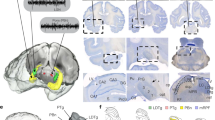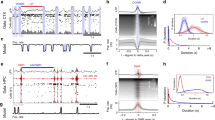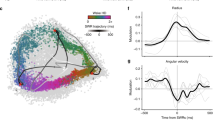Abstract
During quiet wakefulness and sleep, and under anesthesia, the membrane potentials of neocortical pyramidal neurons show synchronous, slow oscillations, so-called up-down states (UDS), that can be detected in the local field potential (LFP). The influence of this synchronized, spontaneous neocortical activity on the hippocampus is largely unknown. We performed the first in vivo whole-cell recordings from hippocampal dorsal CA1 interneurons and found that their membrane potentials were phase-locked to neocortical up-down states with a small delay. These results provide strong evidence for cortico-hippocampal interaction and suggest that neocortical activity drives hippocampal interneurons during UDS.
This is a preview of subscription content, access via your institution
Access options
Subscribe to this journal
Receive 12 print issues and online access
$209.00 per year
only $17.42 per issue
Buy this article
- Purchase on Springer Link
- Instant access to full article PDF
Prices may be subject to local taxes which are calculated during checkout


Similar content being viewed by others
References
O'Keefe, J. & Nadel, L. The Hippocampus as a Cognitive Map (Clarendon Press, Oxford, 1978).
Petersen, C.C.H., Hahn, T.T.G., Mehta, M., Grinvald, A. & Sakmann, B. Interaction of sensory responses with spontaneous depolarization in layer 2/3 barrel cortex. Proc. Natl. Acad. Sci. USA 22, 13638–13643 (2003).
Steriade, M., Timofeev, I. & Grenier, F. Natural waking and sleep states: a view from inside neocortical neurons. J. Neurophysiol. 85, 1969–1985 (2001).
Cowan, R.L. & Wilson, C.J. Spontaneous firing patterns and axonal projections of single corticostriatal neurons in the rat medial agranular cortex. J. Neurophysiol. 71, 17–32 (1994).
Vanderwolf, C.H. Hippocampal electrical activity and voluntary movement in the rat. Electroencephalogr. Clin. Neurophysiol. 26, 407–418 (1969).
Siapas, A.G. & Wilson, M.A. Coordinated interactions between hippocampal ripples and cortical spindles during slow-wave sleep. Neuron 21, 1123–1128 (1998).
Sirota, A., Csicsvari, J., Buhl, D. & Buzsaki, G. Communication between neocortex and hippocampus during sleep in rodents. Proc. Natl. Acad. Sci. USA 100, 2065–2069 (2003).
Battaglia, F.P., Sutherland, G.R. & McNaughton, B.L. Hippocampal sharp wave bursts coincide with neocortical “up-state” transitions. Learn. Mem. 11, 697–704 (2004).
Wolansky, T., Clement, E.A., Peters, S.R., Palczak, M.A. & Dickson, C.T. Hippocampal slow oscillation: a novel EEG state and its coordination with ongoing neocortical activity. J. Neurosci. 26, 6213–6229 (2006).
Freund, T.F. & Buzsaki, G. Interneurons of the hippocampus. Hippocampus 6, 347–470 (1996).
Vida, I., Halasy, K., Szinyei, C., Somogyi, P. & Buhl, E.H. Unitary IPSPs evoked by interneurons at the stratum radiatum-stratum lacunosum-moleculare border in the CA1 area of the rat hippocampus in vitro. J. Physiol. 506, 755–773 (1998).
Amaral, D.G. & Witter, M.P. The three-dimensional organization of the hippocampal formation: a review of anatomical data. Neuroscience 31, 571–591 (1989).
Mehta, M.R., Barnes, C.A. & McNaughton, B.L. Experience-dependent, asymmetric expansion of hippocampal place fields. Proc. Natl. Acad. Sci. USA 94, 8918–8921 (1997).
Miller, R. Cortico-Hippocampal Interplay (Springer-Verlag, New York, 1991).
Huber, R. et al. Arm immobilization causes cortical plastic changes and locally decreases sleep slow wave activity. Nat. Neurosci. 9, 1169–1176 (2006).
Acknowledgements
We thank O. Ahmed, M. Blatow, R. Burwell, D. Haydon Wallace, J. Kauer and S. Schnall for reading the manuscript. M.R.M. was supported by the Rhode Island Foundation grant, the Salomon Foundation grant, US National Institutes of Health/Collaborative Research in Computational Neuroscience grant, a Young Investigator Award from the National Alliance for Research in Schizophrenia and Depression foundation and an early CAREER award from the National Science Foundation.
Author information
Authors and Affiliations
Corresponding authors
Ethics declarations
Competing interests
The authors declare no competing financial interests.
Supplementary information
Supplementary Fig. 1
Cross-correlation coefficient between action potentials (AP) of hippocampal interneurons and neocortical LFP (AP-LFP correlation). (PDF 148 kb)
Rights and permissions
About this article
Cite this article
Hahn, T., Sakmann, B. & Mehta, M. Phase-locking of hippocampal interneurons' membrane potential to neocortical up-down states. Nat Neurosci 9, 1359–1361 (2006). https://doi.org/10.1038/nn1788
Received:
Accepted:
Published:
Issue Date:
DOI: https://doi.org/10.1038/nn1788
This article is cited by
-
Proceedings of the First Pediatric Coma and Disorders of Consciousness Symposium by the Curing Coma Campaign, Pediatric Neurocritical Care Research Group, and NINDS: Gearing for Success in Coma Advancements for Children and Neonates
Neurocritical Care (2023)
-
Moving bar of light evokes vectorial spatial selectivity in the immobile rat hippocampus
Nature (2022)
-
STAT3 inhibitor mitigates cerebral amyloid angiopathy and parenchymal amyloid plaques while improving cognitive functions and brain networks
Acta Neuropathologica Communications (2021)
-
Neuronal firing rates diverge during REM and homogenize during non-REM
Scientific Reports (2019)
-
Common oscillatory mechanisms across multiple memory systems
npj Science of Learning (2017)



